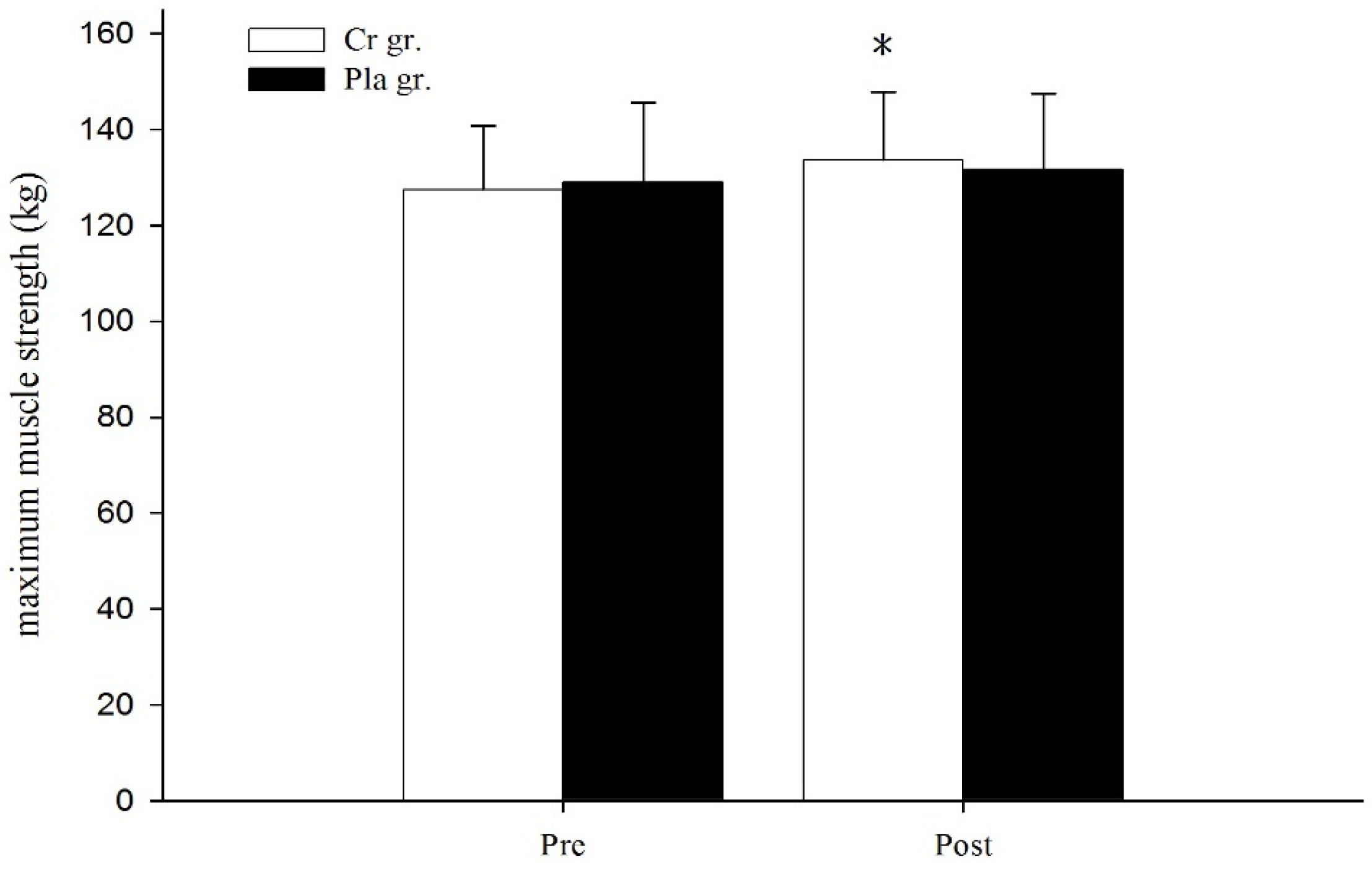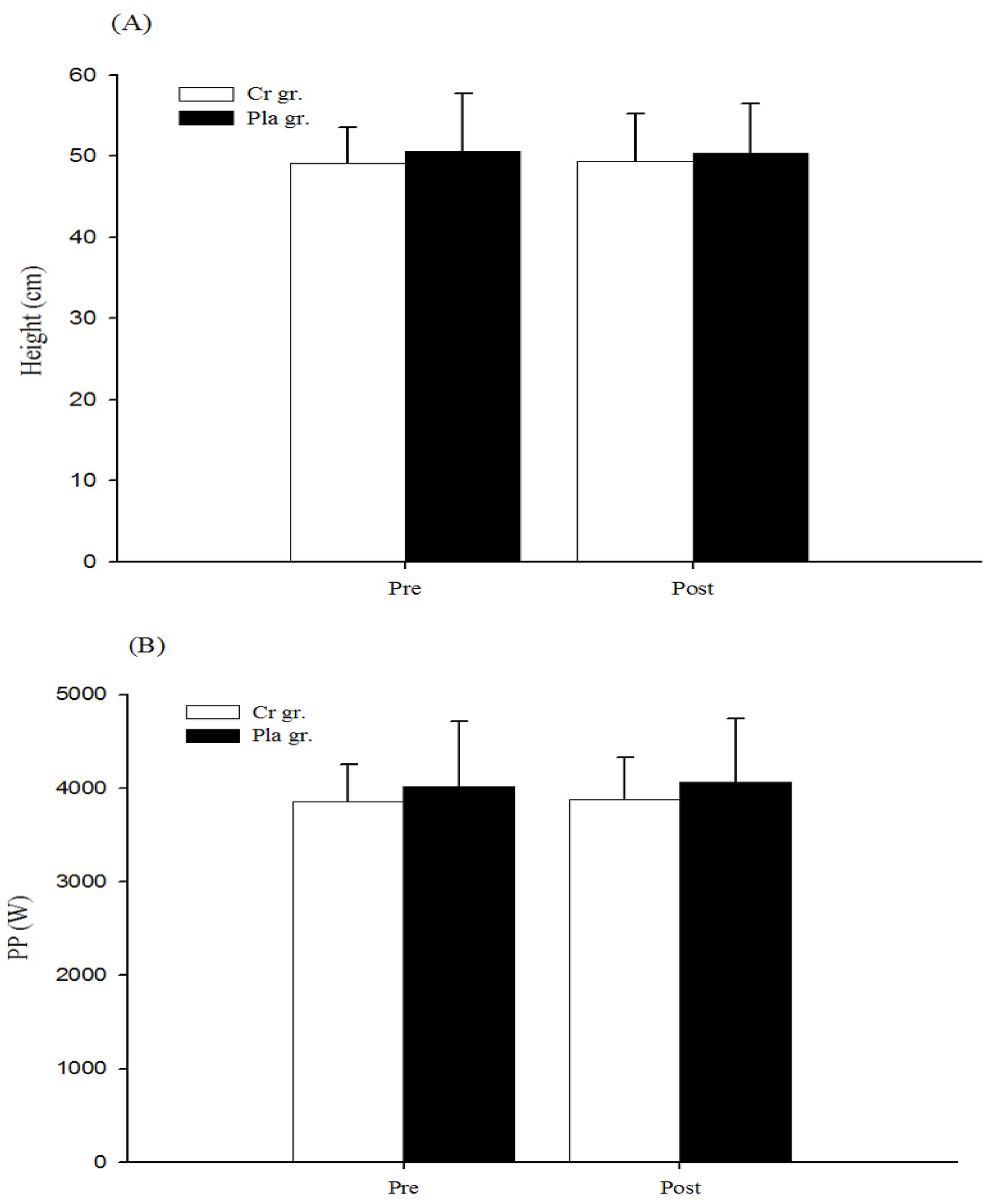The Effects of Creatine Supplementation on Explosive Performance and Optimal Individual Postactivation Potentiation Time
Abstract
:1. Introduction
2. Experimental Section
2.1. Research Design
2.2. Subjects
2.3. Supplementation Protocol
2.4. Prediction of One Repetition Maximum Strength
2.5. Optimal Individual PAP Time and Jump Performance Test
2.6. Anthropometric Measurements
2.7. Statistical Analysis
3. Results
3.1. Subject Characteristics
3.2. Effects of Cr Supplementation on Maximum Muscle Strength and Variables in a Set of Complex Training Bout
3.3. Optimal Individual PAP Time
4. Discussion
5. Conclusions
Acknowledgments
Author Contributions
Conflicts of Interest
References
- Bemben, M.G.; Lamont, H.S. Creatine supplementation and exercise performance: Recent findings. Sports Med. 2005, 35, 107–125. [Google Scholar] [CrossRef] [PubMed]
- Izquierdo, M.; Ibañez, J.; González-Badillo, J.J.; Gorostiaga, E.M. Effects of creatine supplementation on muscle power, endurance, and sprint performance. Med. Sci. Sports Exerc. 2002, 34, 332–343. [Google Scholar] [CrossRef] [PubMed]
- Rahimi, R.; Faraji, H.; Sheikholeslami-Vatani, D.; Vatani, S.D.; Qaderi, M. Creatine supplementation alters the hormonal response to resistance exercise. Kinesiology 2010, 42, 28–35. [Google Scholar]
- Cooper, R.; Naclerio, F.; Allgrove, J.; Jimenez, A. Creatine supplementation with specific view to exercise/sports performance: An update. J. Int. Soc. Sports Nutr. 2012, 9, 33. [Google Scholar] [CrossRef] [PubMed]
- Jones, P.; Lees, A. A biomechanical analysis of the acute effects of complex training using lower limb exercises. J. Strength Cond. Res. 2003, 17, 694–700. [Google Scholar] [PubMed]
- Docherty, D.; Robbins, D.; Hodgson, M. Complex training revisited: A review of its current status as a viable training approach. Strength Cond. J. 2004, 26, 52–57. [Google Scholar] [CrossRef]
- Robbins, D.W. Postactivation potentiation and its practical applicability: A brief review. J. Strength Cond. Res. 2005, 19, 453–458. [Google Scholar] [CrossRef] [PubMed]
- Tillin, N.A.; Bishop, D. Factors modulating post-activation potentiaiton and its effect on performance of subsequent explosive activities. Sports Med. 2009, 39, 147–166. [Google Scholar] [CrossRef] [PubMed]
- Ebben, W.P. Complex training: A brief review. J. Sports Sci. Med. 2002, 1, 42–46. [Google Scholar] [PubMed]
- Hamada, T.; Sale, D.G.; MacDougall, J.D.; Tarnopolsky, M.A. Postactivation potentiation, fiber type, and twitch contraction time in human knee extensor muscles. J. Appl. Physiol. 2000, 88, 2131–2137. [Google Scholar] [PubMed]
- Kilduff, L.P.; Bevan, H.R.; Kingsley, M.I.C.; Owen, N.J.; Bennett, M.A.; Bunce, P.J.; Hore, A.M.; Maw, J.R.; Cunningham, D.J. Postactivation potentiation in professional rugby players: Optimal recovery. J. Strength Cond. Res. 2007, 21, 1134–1138. [Google Scholar] [CrossRef] [PubMed]
- Lorenz, D. Postactivation potentiation: An introduction. Int. J. Sports Phys. Ther. 2011, 6, 234–240. [Google Scholar] [PubMed]
- Chatzopoulos, D.E.; Michailidis, C.J.; Giannakos, A.K.; Alexiou, K.C.; Patikas, D.A.; Antonopoulos, C.B.; Kotzamanidis, C.M. Postactivation potentiation effects after heavy resistance exercise on running speed. J. Strength Cond. Res. 2007, 21, 1278–1281. [Google Scholar] [PubMed]
- Rixon, K.P.; Lamont, H.S.; Bemben, M.G. Influence of type of muscle contraction, gender, and lifting experience on postactivation potentiation performance. J. Strength Cond. Res. 2007, 21, 500–505. [Google Scholar] [PubMed]
- Till, K.A.; Cooke, C. The effects of postactivation potentiation on sprint and jump performance of male academy soccer players. J. Strength Cond. Res. 2009, 23, 1960–1967. [Google Scholar] [CrossRef] [PubMed]
- Duthie, G.M.; Young, W.B.; Aitken, D.A. The acute effects of heavy loads on jump squat performance: An evaluation of the complex and contrast methods of power development. J. Strength Cond. Res. 2002, 16, 530–538. [Google Scholar] [CrossRef] [PubMed]
- Hrysomallis, C.; Kidgell, D. Effect of heavy dynamic resistive exercise on acute upper-body power. J. Strength Cond. Res. 2001, 15, 426–430. [Google Scholar] [PubMed]
- McCann, M.R.; Flanagan, S.P. The effects of exercise selection and rest interval on postactivation potentiation of vertical jump performance. J. Strength Cond. Res. 2010, 24, 1285–1291. [Google Scholar] [CrossRef] [PubMed]
- Bevan, H.R.; Owen, N.J.; Cunningham, D.J.; Kingsley, M.I.C.; Kilduff, L.P. Complex training in professional rugby players: Influence of recovery time on upper body power output. J. Strength Cond. Res. 2009, 23, 1780–1785. [Google Scholar] [CrossRef] [PubMed]
- Crewther, B.T.; Kilduff, L.P.; Cook, C.J.; Middleton, M.K.; Bunce, J.P.; Yang, G.Z. The acute potentiating effects of back squats on athlete performance. J. Strength Cond. Res. 2011, 25, 3319–3325. [Google Scholar] [CrossRef] [PubMed]
- Jo, E.; Judelson, D.A.; Brown, L.E.; Coburn, J.W.; Dabbs, N.C. Influence of recovery duration after a potentiating stimulus on muscular power in recreationally trained individuals. J. Strength Cond. Res. 2010, 24, 343–347. [Google Scholar] [CrossRef] [PubMed]
- Kilduff, L.P.; Cunningham, D.J.; Owen, N.J.; West, D.J.; Bracken, R.M.; Cook, C.J. Effect of postactivation potentiation on swimming starts in international sprint swimmers. J. Strength Cond. Res. 2011, 25, 2418–2423. [Google Scholar] [CrossRef] [PubMed]
- Kilduff, L.P.; Owen, N.; Bevan, H.; Bennett, M.; Kingsley, M.I.; Cunningham, D. Influence of recovery time on post-activation potentiation in professional rugby players. J. Sports Sci. 2008, 26, 795–802. [Google Scholar] [CrossRef] [PubMed]
- McMahon, S.; Jenkins, D. Factors affecting the rate of phosphocreatine resynthesis following intense exercise. Sports Med. 2002, 32, 761–784. [Google Scholar] [CrossRef] [PubMed]
- Branch, J.D. Effect of creatine supplementation on body composition and performance: A meta-analysis. Int. J. Sport Nutr. Exerc. Metab. 2003, 13, 198–226. [Google Scholar] [PubMed]
- Murphy, R.M.; Stephenson, D.G.; Lamb, G.D. Effect of creatine on contractile force and sensitivity in mechanically skinned single fibers from rat skeletal muscle. Am. J. Physiol.-Cell Physiol. 2004, 287, C1589–C1595. [Google Scholar] [CrossRef] [PubMed]
- Wilson, J.M.; Duncan, N.M.; Marin, P.J.; Brown, L.E.; Loenneke, J.P.; Wilson, S.M.; Jo, E.; Lowery, R.P.; Ugrinowitsch, C. Meta-analysis of postactivation potentiation and power: Effects of conditioning activity, volume, gender, rest periods, and training status. J. Strength Cond. Res. 2013, 27, 854–859. [Google Scholar] [CrossRef] [PubMed]
- Sale, D.G. Postactivation potentiation: Role in human performance. Exerc. Sport Sci. Rev. 2002, 30, 138–143. [Google Scholar] [CrossRef] [PubMed]
- Tsimahidis, K.; Galazoulas, C.; Skoufas, D.; Papaiakovou, G.; Bassa, E.; Patikas, D.; Kotzamanidis, C. The effect of sprinting after each set of heavy resistance training on the running speed and jumping performance of young basketball players. J. Strength Cond. Res. 2010, 24, 2102–2108. [Google Scholar] [CrossRef] [PubMed]
- Comyns, T.M.; Harrison, A.J.; Hennessy, L.K.; Jensen, R.L. The optimal complex training rest interval for athletes from anaerobic sports. J. Strength Cond. Res. 2006, 20, 471–476. [Google Scholar] [PubMed]
- Baechle, T.R.; Earle, R.W. Essentials of Strength Training and Conditioning, 3rd ed.; Human Kinetics Publishers: Champaign, IL, USA, 2008; pp. 406–413. [Google Scholar]
- Mitchell, C.J.; Sale, D.G. Enhancement of jump performance after a 5-rm squat is associated with postactivation potentiation. Eur. J. Appl. Physiol. 2011, 111, 1957–1963. [Google Scholar] [CrossRef] [PubMed]
- Cohen, J. Statistical Power Analysis for the Behavioral Sciences, 2nd ed.; Lawrence Erlbaum Associates Inc.: Hillsdale, NJ, USA, 1988; pp. 19–66. [Google Scholar]
- Urbanski, R.L.; Loy, S.F.; Vincent, W.J.; Yaspelkis, B.B., 3rd. Creatine supplementation differentially affects maximal isometric strength and time to fatigue in large and small muscle groups. Int. J. Sport Nutr. 1999, 9, 136–145. [Google Scholar] [PubMed]
- Zuniga, J.M.; Housh, T.J.; Camic, C.L.; Hendrix, C.R.; Mielke, M.; Johnson, G.O.; Housh, D.J.; Schmidt, R.J. The effects of creatine monohydrate loading on anaerobic performance and one-repetition maximum strength. J. Strength Cond. Res. 2012, 26, 1651–1656. [Google Scholar] [PubMed]
- Requena, B.; Gapeyeva, H.; García, I.; Ereline, J.; Pääsuke, M. Twitch potentiation after voluntary versus electrically induced isometric contractions in human knee extensor muscles. Eur. J. Appl. Physiol. 2008, 104, 463–472. [Google Scholar] [CrossRef] [PubMed]
- Arazi, H.; Rahmaninia, F.; Hoseini, K.; Asadi, A. Effects of three, five and seven days of creatine loading on muscle volume and functional performance. Serb. J. Sports Sci. 2011, 5, 99–105. [Google Scholar]
- Kreider, R.B. Effects of creatine supplementation on performance and training adaptations. Mol. Cell. Biochem. 2003, 244, 89–94. [Google Scholar] [CrossRef] [PubMed]
- Stout, J.R.; Anthony, J.; Kalman, D. Essentials of Creatine in Sports and Health; Humana Press Inc.: Totowa, NJ, USA, 2008; pp. 25–27. [Google Scholar]
- Naclerio, F.; Chapman, M.; Larumbe-Zabala, E.; Massey, B.; Neil, A.; Triplett, T.N. Effects of three different conditioning activity volumes on the optimal recovery time for potentiation in college athletes. J. Strength Cond. Res. 2015, 29, 2579–2585. [Google Scholar] [CrossRef] [PubMed]


| Variable | Cr gr. (n = 15) | Pla gr. (n = 15) |
|---|---|---|
| Age (years) | 19.93 ± 1.86 | 19.46 ± 1.12 |
| Height (cm) | 171.93 ± 4.86 | 175.93 ± 8.49 |
| Weight (kg) | 66.98 ± 6.74 | 70.24 ± 11.14 |
| Body fat (%) | 15.13 ± 5.06 | 13.66 ± 4.37 |
| Subjects | Cr gr. | Pla gr. | ||
|---|---|---|---|---|
| Pre (Min) | Post (Min) | Pre (Min) | Post (Min) | |
| 1 | 3 | 5 | 5 | 3 |
| 2 | 7 | 3 | 4 | 4 |
| 3 | 5 | 5 | 4 | 12 |
| 4 | 11 | 3 | 7 | 5 |
| 5 | 4 | 6 | 7 | 7 |
| 6 | 5 | 2 | 5 | 6 |
| 7 | 4 | 2 | 8 | 10 |
| 8 | 6 | 5 | 9 | 5 |
| 9 | 8 | 1 | 3 | 1 |
| 10 | 6 | 5 | 3 | 6 |
| 11 | 6 | 5 | 6 | 7 |
| 12 | 5 | 3 | 8 | 9 |
| 13 | 12 | 4 | 7 | 10 |
| 14 | 6 | 4 | 2 | 7 |
| 15 | 4 | 7 | 2 | 4 |
| Mean ± SD | 6.13 ± 2.53 | 4.00 ± 1.64 * | 5.33 ± 2.28 | 6.40 ± 2.94 # |
© 2016 by the authors; licensee MDPI, Basel, Switzerland. This article is an open access article distributed under the terms and conditions of the Creative Commons by Attribution (CC-BY) license (http://creativecommons.org/licenses/by/4.0/).
Share and Cite
Wang, C.-C.; Yang, M.-T.; Lu, K.-H.; Chan, K.-H. The Effects of Creatine Supplementation on Explosive Performance and Optimal Individual Postactivation Potentiation Time. Nutrients 2016, 8, 143. https://doi.org/10.3390/nu8030143
Wang C-C, Yang M-T, Lu K-H, Chan K-H. The Effects of Creatine Supplementation on Explosive Performance and Optimal Individual Postactivation Potentiation Time. Nutrients. 2016; 8(3):143. https://doi.org/10.3390/nu8030143
Chicago/Turabian StyleWang, Chia-Chi, Ming-Ta Yang, Kang-Hao Lu, and Kuei-Hui Chan. 2016. "The Effects of Creatine Supplementation on Explosive Performance and Optimal Individual Postactivation Potentiation Time" Nutrients 8, no. 3: 143. https://doi.org/10.3390/nu8030143




